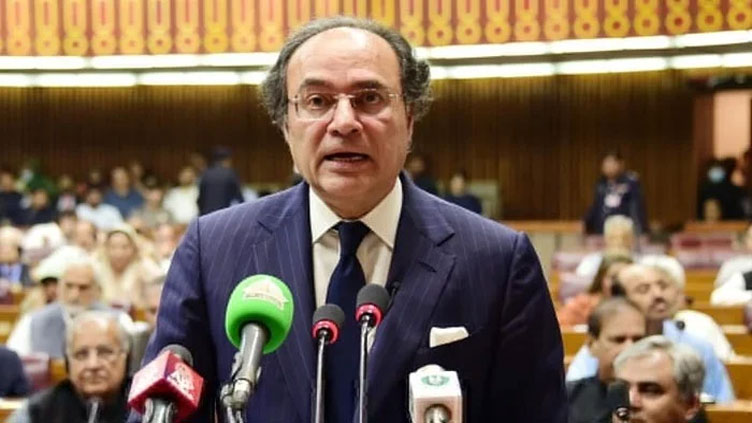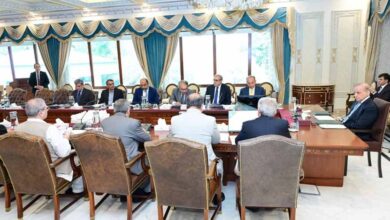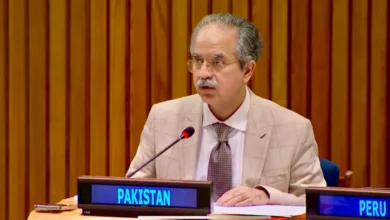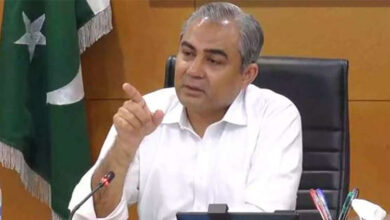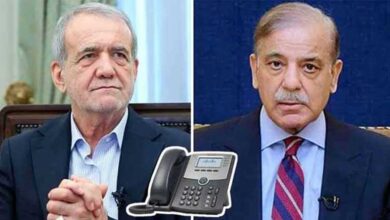ISLAMABAD: Federal Finance Minister Muhammad Aurangzeb on Tuesday presented the Rs17,573 billion budget for the fiscal year 2025-26 with the total outlay of Rs17,573 billion.
Starting his speech, the finance minister said he was honoured to present second budget for the incumbent government. He thanked Prime Minister Shehbaz Sharif, Bilawal Bhutto Zardari, Khalid Maqbool Siddiqui and others for their support in the budget.
He said the timing of the budget was historic as the whole nation was united against India during the recent tensions.
“This budget comes at a pivotal time for our nation’s future,” he mentioned, praising the nation’s military and political leaders for their “successful handling of war-like situation” with India.
Scenes of pandemonium were observed as soon as the budget session commenced as the opposition members started disrupting the speech of the finance minister.
He said the IMF has shown trust in the reforms undertaken by the incumbent government and those claiming about the minibudget have turned silent now.
Defence Allocation
Rs2,550 billion have been allocated for the defence sector. Last year Rs2,122 were reserved for defence.
The federal government had allocated Rs920 billion in the federal budget for 2017-18, Rs1,100 billion in 2018-19, Rs1,153 billion in 2019-20, Rs1,289 billion in 2020-21, Rs1,370 in 2021-22 and Rs1,563 billion in the budget for 2022-23.
Development projects
The federal government has allocated Rs1,000 billion for the Public Sector Development Programme (PSDP) for the next fiscal year, prioritizing infrastructure, energy, water, and regional development initiatives.
As per documents, Rs662 billion is allocated to 31 federal ministries and divisions, while Rs332 billion is reserved for state-owned entities, including the National Highway Authority.
Budget Deficit, Inflation and GDP Growth
The budget deficit is 6,501 billion. It showed a slight decrease from the last year when the deficit was 7,283 billion.
The federal government has set an inflation target of 7.5% for FY2025-26 in an effort to stabilise prices and curb inflationary pressures.
The economic growth for the fiscal year 2025-26 is estimated at 4.2percent. Last year, the growth was projected at 3.6pc.
Interest Payment On Loans
An amount of Rs8,207 billion has been earmarked for interest payments on loans.
Agricultural, Industrial and Services sectors
The government also proposed a 4.5pc growth target for the agriculture sector. Meanwhile, a national committee would be established by the Prime Minister to coordinate on this subject between the centre and provinces. Moreover, small farmers would be given loans aimed at uplifting them. The growth is set at 4.3pc for industrial development, and 4pc for the services sector.
Revenue Targets
The government has set the FBR’s revenue collection target at Rs14,131 billion for FY2025-26.
Federal Non-Tax Revenue
The target for federal non-tax revenue has been set at Rs5,187 billion. Last year, the non-tax revenue was set at Rs3,587 billion.
Tax ratio on cash withdrawal increased for non-filers
The government has increased tax ratio on cash withdrawals by the non-filers in the budget for FY2025-26.
In the budget for FY 2025-26, the tax ratio on cash withdrawals by non-filers has been increased from 0.6pc to 1pc.
Non-filers will also no longer be allowed to open bank accounts.
Energy Reforms
As for the energy sector, the government reduced the electricity prices for the industrial sector upto 31pc. The electricity prices were also reduced for the deserving 10.8 million people. Also, the government renewed agreements with indepedent power producers (IPPs) and closed down power plants running on furnace fuel.
Salaries and Pensions
The federal government has increased salaries of the government employees by 10 percent. Moreover, pensions have been increased by 7 percent. Rs1,055 billion have been reserved for pensions.
Reduced taxes on the salaried class
A significant tax relief for the salaried class in the new budget has been announced which has reduced tax slabs across all income levels.
Individuals earning between Rs600,000 and Rs1,200,000 annually will now be taxed at a rate of just 1pc.
Moreover, for those earning Rs1.2 million per year, the proposed tax has been slashed from Rs30,000 to Rs6,000—offering substantial relief to middle-income earners.
Further revisions include a reduction in the tax rate for salaries up to Rs2.2 million, from 15 per cent to 11 per cent, while individuals earning between Rs2.2 million and Rs3.2 million will now pay tax at 23 per cent, down from the previous rate.
IT Exports
IT exports have increased by 21.2 percent. In ten months, the IT exports have jumped to 3.1 billion dollars. The government has planned to increase the IT exports to 25 billion dollars.
Education Sector
Rs9.8 billion allocated for the establishment of 11 new Daanish Schools, while an additional Rs18.5 billion set aside for other education projects.
For higher education, the Higher Education Commission (HEC) has been allocated Rs39.5 billion for 170 projects. In the fiscal year 2025-26, Rs4.8 billion has been reserved for 31 science and technology projects.
Climate Change
The government has focused a lot on climate finance strategy. Pakistan would get 40 billion dollars in the next 10 years under the World Bank and IFCC country partnership framework.
BISP
10 million children were supported under this program. 9.9 million families were supported financially.
Earlier, the federal cabinet on Tuesday approved the budgetary proposals for the fiscal year 2025-26.
Chaired by Prime Minister Shehbaz Sharif, the special cabinet committee deliberated on the budget proposals and accorded its approval to the Finance Bill.
The cabinet meeting also okayed the budgetary proposals to be presented before the National Assembly for its onward consideration.
The government has already announced increase in salaries and pensions of its employees, and a likely tax relief for them. The current account deficit for the fiscal year 2025–26 is estimated to be -0.5% of the GDP.
For the upcoming fiscal year, the export target has been set at $35.3 billion, while the import target is set at $65.2 billion. The federal revenue for the next fiscal year is expected to reach up to Rs19.3 trillion.
The FBR’s tax collection target is proposed to be over Rs14 trillion. The target for economic growth has been set at 4.2%. The size of the Public Sector Development Programme (PSDP) is expected to be Rs1 trillion.
In the new budget, it is proposed to allocate Rs8.3 trillion to the provinces under the National Finance Commission (NFC) Award, and Rs2.55 trillion for defense. The budget deficit is estimated to be around Rs6 trillion. A sum of Rs8.5 trillion will be spent on interest payments on debt.
ECONOMIC SURVEY OF PAKISTAN UNVEILED
On Monday, Finance Minister Muhammad Aurangzeb unveiled the Economic Survey for the fiscal year 2024–25, a key pre-budget document that outlines the government’s assessment of the national economy.
Addressing a presser later, the finance minister said that the policy rate had been reduced significantly from 22% to 11%, a strong indicator of stabilizing economic conditions.
Also read: NA speaker approves budget schedule
“We are moving towards stability,” the minister remarked, adding that he appreciates the constructive steps taken by the caretaker setup.
Discussing macroeconomic performance, the finance minister stated that Pakistan’s GDP growth in the current fiscal year reached 2.7%, a significant rebound from 2023, when the country experienced negative growth.
The finance minister stated that Pakistan experienced a significant increase in the foreign exchange reserves during the current fiscal year, while also implementing crucial structural reforms aimed at transforming the economy’s DNA.
Gohar Ejaz calls for 5-year industrial policy, lower taxes
Giving proposals on federal budget for 2025-26, Economic Policy Think Tank Chairman and former commerce minister Dr Gohar Ejaz has said industry should be the top priority, stressing permanent five-year industry and export policy.
In his tweet on the budget proposals, Dr Gohar Ijaz wrote that an interest rate of 6 percent and energy rates of 9 cents per unit for industry are very important.
The maximum tax rate for salaried individuals should be limited to 20 percent.
He said that the super tax should only be applied to corporations whose profits exceed Rs10 billion.
The former federal commerce minister said that the withholding tax on tax filer property buyers discourages homeowners and it should be withdrawn.
It is important to modernise agriculture and ensure productivity, the former finance said.

